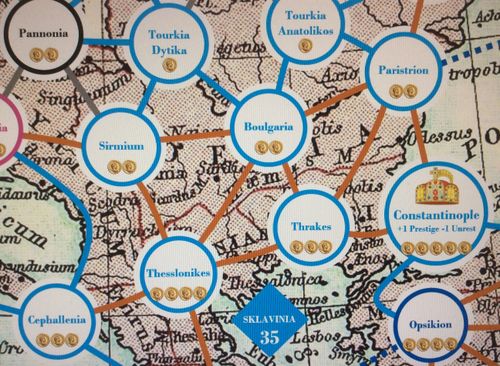|
Advertisement
|
Rome, LLC.: From Heraclius to Manzikert

DescriptionRome, LLC. is a game of the Eastern Byzantine Empire and Western Frankish Empire from the unification of the Frankish Kingdom by King Chlothar II in 613 CE. to the disastrous defeat of Emperor Romanos IV to the Seljuk Turks at Manzikert in 1071 CE, which precipitated the Crusades. Heraclius overthrew the Emperor Phocas in 610 CE, but his prolonged war with Persia weakened the Byzantine Empire, which almost collapsed to the might of Islam and the invading Avars, Bulgars, and Slavs. The Empire survived thanks to the Theodosian Walls of Constantinople, the secret of Greek Fire, and capable leaders such as John Kurkuas, John Tzimiskes, and Basil the Bulgar-Killer, who reconquered territory lost to the barbarians. King Chlothar II united the Frankish Kingdom in 613 CE, but his inept successors were replaced by the warlord Charles Martell, who repelled the Islamic Invasion at Tours in 732 CE. His grandson Charlemagne invaded Germany, Spain, and Italy and in 800 CE was crowned Emperor by Pope Leo III, reviving the Western Roman Empire. Like its predecessor the Frankish Empire slowly fell apart, divided by civil war, and devastated by Norse and Magyar raiders. The last Carolingian ruler died in 987 CE and the empire split into warring kingdoms. Two players may play Rome, LLC. one controlling the Eastern Byzantine Empire and the other the Western Frankish Empire. The Byzantines have the larger, wealthier, empire, but their enemies are more dangerous. The weaker economy of the Franks makes them more dependent on allies and marcher lords to guard the frontier and must expand their kingdom into an empire. Each plays their own game side-by-side, with their own statesmen and units, co-operating against invading Arabs, Avars, Bulgars, Magyars, Moors, Norse, Rus, Saxons, Seljuks, and Slavs. The game may be played solitaire, with the player either controlling one empire, or both at the same time. Each empire has its own statesmen who are made emperors, kings, governors, or rebels. They are rated for their military, administration, religion, and intrigue abilities, and each has a special ability. St Boniface reformed the Frankish Church and the evangelist of Germany, so is a Western Statesman with 1 Military ability, 4 Administration ability, 5 Religious ability, 2 Intrigue ability, and the Convert special ability. The map has provinces grouped into commands with their own governors, who collects taxes, quells insurgents, fights wars, but may assassinate their emperor or rebel and start a civil war. Emperors counters are used to change commands and rules and determine which statesmen of the new dynasty will become emperor, regardless of their abilities (or lack thereof). Victory is determined by winning Prestige, which is earned by imperial administration, annexing provinces, defeating wars, and financing prestige projects. The loss of both Constantinople and Rome to the barbarians results in defeat, but bankruptcy and unrest can also drive an empire to destruction. Rome, LLC. uses the system from Rome, Inc. (ATO 53). Each turn represents 5-10 years, with 10 turns in each scenario. The five scenarios start in 610 CE, 711 CE, 814 CE, 888 CE, and 973 CE which may be combined into campaign games. Players may continue the scenarios from Rome, Inc. and Rome, IInc. into Rome, LLC. allowing them to play 17 consecutive scenarios covering 1500 years of history. —description from the designer Game DiscussionsAdd CommentYou need to be logged in to comment. Insert Bullet List Please enter at least one item. Item: Item: Item: Item: Item: Insert Numeric List Please enter at least one item. Item: Item: Item: Item: Item: Insert Link Please enter the link of the website Optionally you can add display text Insert Email Please enter the email address Optionally add any display text Insert Image Please enter the link of the image Insert YouTube Video Please enter the link of the video Marketplace | ||||

Comments (0)